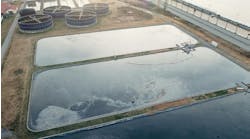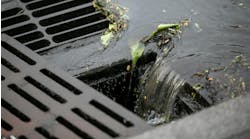Water optimization efforts often focus on achieving the highest possible level of recycling. However, many plants also should consider a complementary approach that targets cutting the water use of specific unit operations. When well planned and executed, this can produce substantial savings, as recent projects by BHS-Sonthofen, Suez Water Technologies And Solutions and DuPont Water Solutions show.
Processes that use washing and clarification technologies are ripe for optimization, advises Barry A. Perlmutter, president and managing director of BHS-Sonthofen Inc., Charlotte, N.C.
“Processes which use washing technology such as belt filters [Figure 1] can make savings of over 30% in water use by switching to counter-current washing. You can recycle the filtrate with no change in the quality of the washing process,” he says.
As an example, he cites a recently completed project for a company that was using 762 kg/h of demineralized water in a once-through washing process. Using counter-current washing in a new process reduced this to 518 kg/h.
“Here, a 2-m2 vacuum belt filter was installed. Counter-current washing technology added approximately 7% to the capital cost for the project. The overall operating costs for water usage were reduced by over 30%,” he notes.
However, success in this and other water optimization projects relies on thorough laboratory testing by BHS, he emphasizes. “Lab testing for counter-current washing requires a lot of patience as filtrates must be recovered and kept in separate beakers. This is crucial to determine both the water savings and final product quality.”
Figure 1. Boxes on top of structure feed wash devices on belt filter. Source: BHS-Sonthofen.
Most clients believe that the savings in the volume of water used more than offset the added capital expenditure involved, e.g., for piping, pumps and control, he adds.
Turning to clarification processes, Perlmutter notes that using plate or candle filters sometimes enables achieving almost 100% water recovery.
He cites two recent projects. In both, customers attained a complete water balance by removing solids from the mother liquor and returning them to the final product while also recycling all the water. “With what is now effectively ZLD [zero liquid discharge], they are making ongoing savings in terms of water use,” he stresses.
The first company installed two vacuum belt filters, each 73.5 m2, and two pairs of candle filters for clarification. The first pair, each 12.5 m2, removes solids from the mother liquor; the solids get returned to the slurry feed tank. The other pair, each 5 m2, recover solids from the product wash water; these go to the final product dryer. The water in both cases is reused.
The second customer, a refining company, reduced water use ten-fold after installing two 20-m2 candle filters and a 4-m2 pressure plate filter. The cake wash water from the candle filters serves as wash water for the regeneration of ion exchange resins. “This eliminates the use of fresh water and minimizes the dilution of the amine in the scrubbing process,” Perlmutter explains.
Replacing Metal Cartridges
Opting for an alternative to backwashable metal cartridges for water scrubbing and clarifier effluent concentrating also can save water, he adds.
He cites a case where the wet scrubber water purge goes to a clarifier for primary removal of large catalyst solids; the clarifier overflow discharges to an oxidation tower with the effluent from the tower pumped through the effluent filter and heat exchanger prior to discharge.
The flow rate is 46 mm3/h with a solids concentration of 200 ppm. The particle size is below 1.0 micron. The filtrate specification for discharge is less than 15 ppm.
Initially, the site planned to use backwashable metal cartridges but found their low dirt holding capacity and need for frequent backwashing, with the wash water then sent back to the clarifier, made them uneconomical.
Because this process required a concentrated slurry rather than a dried cake, BHS installed two 25-m2 candle filters. The candle filter technology provides clear filtrates to less than 1 ppm as well as less backwash to the clarifier because the candles are “cleaned” with compressed gas, not liquid.
Customers constantly want to reduce water use further while at the same time improve product quality — which poses a two-fold challenge to a filter vendor, notes Perlmutter. First, it must rely on filter media suppliers to produce finer grades of media with smaller pores — yet with thinner fibers to maintain permeability. Second, the vendor must figure out how to use these finer, very thin and flexible materials in the filtration equipment without damaging the media during the installation. “This requires new designs to hold the media in place and avoid possible bypass of the media by the solids,” he explains.
Savings With Slurries
Many processes involve slurries. Typically, plants opt for rubber-lined centrifugal pumps to move these slurries. However, as Todd Loudin, president of Flowrox, Linthicum, Md., counselled in his article “Save Water When Handling Slurries,” using a different type of pump can significantly pare water consumption. This, he explains, is because centrifugal pumps typically only can cope with streams containing up to about 30% solids while other options such as peristaltic pumps can tolerate more concentrated slurries.
As an example he cites the case of having to move 100t/h of a solid through a process. A 30%-solids slurry suitable for a centrifugal pump will require 233 t/h of water. In contrast, a peristaltic pump can handle a slurry containing 60–80% solids; providing a 65%-solids slurry for the pump would call for only 54 t/h of water. This translates to about 2 million gal/y for the centrifugal pump versus 500,000 gal/y for the peristaltic. Moreover, the extra water consumed by using the centrifugal pump adds to the burden on reclaiming and reconditioning operations.
In addition, for slurries requiring thickening later, the higher solids concentration permitted by peristaltic and other pumps may translate into savings in downstream filtration equipment, he notes.
Demineralization Dilemma
Water issues can arise gradually in ion exchange systems, cautions Gregoire Poirier-Richer, a senior boiler product applications specialist at Suez Water Technologies and Solutions, Gatineau, Quebec. “Resin fouling is devious because it builds up over a long period of time and its effect on water quality and system efficiency is very gradual. Operators get used to a sub-optimal process and the related cost is not as obvious as an equipment failure that has a drastic impact on production and high repair cost.”
A project completed earlier this year by Suez at the ammonia production facility at a fertilizer plant in North America (Figure 2) illustrates what can happen. The fertilizer company couldn’t produce enough makeup water from its ion exchange demineralization plant, which long had suffered with capacity and quality problems.
[sidebar id =2]
The ion exchange demineralization process included primary strong acid cation (SAC) and strong base anion (SBA) trains, followed by mixed bed polishers.
Compliance with minimum water quality limits required a higher frequency of regeneration of the ion exchange resins — with the associated costs — and then treatment of the excess rinse water subsequently produced.
The fertilizer plant’s steam system operated at 1,500 psig and, so, required extremely pure feedwater. However, the demineralization system had run for many years without any performance assessments. It turned out the conductivity of the produced water leaving the SBA train, instead of being the desired >5 µmhos, was closer to 50 µmhos.
A whole host of problems ensued. For example, the mixed bed polishers needed daily regeneration, which was more frequent than the design specification, and the SBA regenerations required excessive washes to achieve the appropriate conductivity.
At the same time, the quality of rinse water coming to the SBAs directly from the SACs implied a very fast depletion rate for the SACs.
A shortage of treated water also loomed. The excessive time spent on regenerations due to extended rinses mandated taking multiple trains offline simultaneously, despite the plant being designed to operate with only one train offline at a time.
Analysis by Suez determined the system at best was operating at 35% of design capacity and the high frequency of regenerations was costing over $400,000/y in extra acid and caustic. In addition, the facility risked breaching containment and environmental regulations as it struggled to store the excess water.
One of the main problems turned out to be organic material made up of large anionic molecules from the degradation of surrounding vegetation that found its way into the facility’s raw water.
Highly attracted to the anion resin, these organic molecules act as a “glue” both on and within the beads. Besides reducing exchange capacity, they absorb some of the caustic used during regeneration. This, in turn, slowly elutes from the glue, giving a steady stream of high conductivity water — and, hence, necessitating the very long rinse times.
Suez’s answer was to implement a brine squeezing process in which sodium chloride brine and a caustic solution, along with specialty dispersants, are passed multiple times through the ion exchange resin beads.
Each brine squeeze extracts organic material from the beads. Usually after five such procedures, the anion resin is deemed clean.
After the implementation, water conductivity out of the SBAs consistently was below 2 µmhos and regenerations were extended from one per day to twice per week — a 70% reduction in regenerant usage.
This significant decrease in primary anion effluent conductivity also drastically cut the load on the mixed bed polishers, reducing their regeneration frequency from once per day to twice per month.
The project has saved the company $320,000 in resin replacement costs so far, while freeing operators from the constant hazardous task of managing regenerations and enabling them to focus on value-oriented projects, states Suez. In addition, the lower frequency of regenerations and shorter rinse times significantly pared the volumes of raw water required and wastewater discharged. The volume of water saved to date is estimated at 4.4 million gal.
Going Beyond Clarification
The River Brazos provides freshwater to an ethylene production facility in Freeport, Texas, along with local farmers and communities. However, two factors promise to put increasing pressure on this supply: a predicted 47% rise in demand from users in the Brazos basin in the coming decades; and increasingly unpredictable weather patterns in Texas over the last decade, which many blame on climate change.
“For example, just five months after Hurricane Harvey hit the Texas Gulf Coast and caused record flooding, almost 40% of the state faced moderate-to-severe drought conditions,” notes Andrea Lima, business development manager, DuPont Water Solutions, Corpus Christi, Texas.
She also points out that if the effects of climate change persist in the way that estimates currently predict, a 2°C rise in global temperature could lead to a 10–30% decrease in annual water discharge in the Brazos River.
Then there’s the issue of the feedwater itself, which Lima describes as notoriously variable in terms of turbidity.
The raw water entering the ethylene plant’s treatment system has an average nephelometric turbidity unit (NTU) of 50 and an average pH of 8.8. The temperature of the feed water averages 24.3°C but spans a range from 7.5°C to 37.8°C. The total organic carbon of the feed water averages 5.0 mg/L while alkalinity averages 135 mg/L as calcium carbonate.
The previous onsite water treatment plant relied solely on clarification and struggled to consistently provide the required treated-water quality targets, including a turbidity limit of less than 1 NTU.
“Conventional technology, like clarification, is often not able to tolerate significant and rapid water quality changes, such as an increase of solids and decrease of alkalinity often associated with rainfall,” explains Lima.
So, to achieve greater consistency, the plant in April 2017 started up a new 23-million-gal/d water treatment plant. At the heart of this, following clarification, is a fully automated filtration process utilizing DuPont IntegraFlux SFP 2880XP ultrafiltration (UF) modules with a 0.03-micron pore size.
The new system effectively removes solids, requires lower pressure and produces consistent higher-quality water than traditional clarification alone.
“While the raw water entering the new system has an average turbidity of 50 NTU, the clarifier system is typically able to provide UF feed water of less than 3 NTU. The UF membrane system has consistently produced filtrate water with less than 0.1 NTU, with an average of 0.01 NTU,” she adds.
The rated capacity of each of the 12 skids is 1,600 gal/min but the average flow to each skid over a 12-month period was closer to 1,400 gal/min. This lower flow rate resulted in reduced flux, which together with membrane performance, allowed for lower fouling potential as evidenced by consistently low transmembrane pressure (TMP). The TMP has stayed below 6 psi — well below the 30 psi maximum TMP – which indicates the backwash and mini-clean-in-place procedures are working properly to keep the membranes clean.
After one year of operation, permeability had dropped only minimally from the initial permeability range of 10–12 gal/ft2/d/psi. Today, the system operates in the range of 9–11 gal/ft2/d/psi and reduces the plant’s freshwater use by 1.3 billion gal/y.
“The consistent water quality produced by the UF system, even after Hurricane Harvey hit the Texas Gulf Coast, left no question that membrane filtration can handle water quality upsets. The plant’s strong performance has become a success model for other sites looking to achieve similar water optimization results,” concludes Lima.
Seán Ottewell is Chemical Processing’s Editor at Large. You can email him at [email protected]




